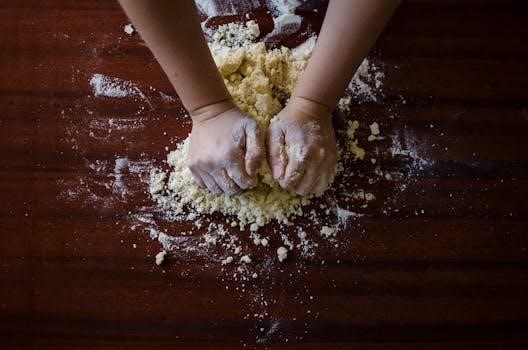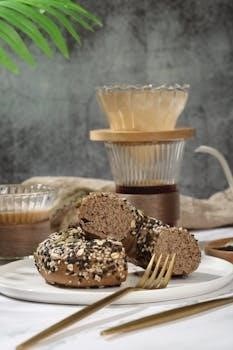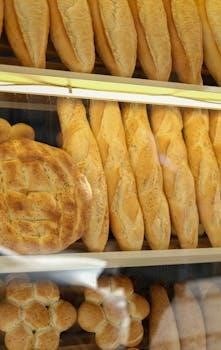Panasonic bread makers offer a convenient way to bake fresh bread at home, and a wide variety of recipes are available in PDF format. These digital guides provide clear instructions for creating different types of loaves, from basic white bread to more complex options. Using a PDF recipe ensures accuracy and consistency in your baking results, making it easier for both beginners and experienced bakers to achieve success.
Understanding the Bread Maker’s Functionality
Panasonic bread makers are designed with automated cycles that simplify the bread-making process. These machines typically include a bread pan, a kneading blade, and a control panel that allows users to select various settings for different types of bread. Understanding how the machine kneads, proofs, and bakes the dough is crucial for successful outcomes. The yeast dispenser, present in some models, ensures that yeast is added at the optimal time. Additionally, the machine’s programming allows for adjustments in crust color, loaf size, and baking time. Knowing the function of each component and cycle empowers bakers to utilize PDF recipes effectively and troubleshoot any potential issues. Many models also include a timer, allowing for delayed starts and fresh bread ready at the desired time. The user manual, often available in PDF form, is an essential resource for learning the specifics of your particular model.
Importance of Using PDF Recipe Guides
PDF recipe guides are invaluable resources for Panasonic bread maker users due to their accessibility and structured format. These guides offer a convenient way to access and store a variety of recipes, ensuring that users can easily replicate successful bakes. Unlike online sources that can change or disappear, a downloaded PDF provides a stable and reliable reference. They often include detailed instructions, ingredient lists with precise measurements, and sometimes even helpful images. The clear layout of a PDF guide eliminates guesswork, especially for novice bakers. Furthermore, the ability to print these guides makes them easy to use right in your kitchen without needing a screen nearby. PDF guides ensure that users have consistent results by following recipes designed specifically for their bread maker model; They also provide a way to organize and categorize your favorite bread recipes.

Types of Recipes Available in PDF Format
PDF format recipe guides for Panasonic bread makers include basic white bread, whole grain options, sweet treats, and gluten-free alternatives. These guides offer a diverse range of recipes to suit various tastes and dietary needs.
Basic White Bread Recipes
The cornerstone of any bread maker recipe collection, basic white bread recipes are readily available in PDF format for Panasonic machines. These recipes are designed to be simple and straightforward, perfect for beginners or those seeking a classic loaf. Typically, these recipes utilize ingredients such as bread flour, water, yeast, salt, and a touch of sugar or oil. The goal is to create a soft, fluffy interior with a golden-brown crust, providing a versatile base for sandwiches, toast, or simply enjoying with butter. Many PDF guides offer variations on the basic recipe, allowing for adjustments in texture and flavor, such as adding milk powder for a softer crumb or experimenting with different types of sugar. The detailed instructions in the PDF guides ensure that even first-time users can achieve consistent results, making it a great starting point for exploring the world of bread making with a Panasonic machine. These recipes often include notes on yeast activation and ingredient order, crucial for success.

Whole Grain Bread Recipes
For those seeking a healthier option, Panasonic bread maker recipes in PDF format also include a variety of whole grain bread recipes. These recipes utilize flours such as whole wheat, rye, spelt, and oats, offering a nutritional boost compared to traditional white bread. Whole grain recipes often require a slightly different approach to mixing and proofing, and PDF guides provide specific instructions to ensure the proper development of gluten and flavor. These recipes sometimes incorporate additions like seeds, nuts, and dried fruits to enhance both the taste and texture. The guides often highlight the importance of using fresh, high-quality ingredients to achieve the best results. They also provide guidance on adjusting liquid content due to the higher fiber content of whole grain flours. These PDF documents are crucial for achieving the desired rise, crumb structure, and overall taste, making it easy to enjoy wholesome, homemade bread with a Panasonic bread maker.
Sweet Bread and Dessert Recipes
Beyond basic and whole grain options, Panasonic bread maker recipe PDFs often feature a delightful selection of sweet bread and dessert recipes. These recipes showcase the versatility of the bread maker, allowing users to create treats like cinnamon rolls, brioche, and even fruit-filled loaves. Sweet bread recipes typically involve the addition of sugar, butter, eggs, and flavorings such as vanilla or citrus zest, resulting in rich and decadent baked goods. The PDF guides often include tips for achieving the perfect level of sweetness and texture, and they may also offer variations on classic recipes. Some guides also provide recipes for dessert-like breads such as chocolate bread or those incorporating ingredients like pumpkin, dried apricots, or nuts. The detailed instructions in these PDF documents ensure that even novice bakers can successfully bake sweet treats with their Panasonic bread maker, expanding their baking possibilities.
Gluten-Free Bread Options
For those with dietary restrictions, Panasonic bread maker recipe PDFs also cater to gluten-free baking. These recipes typically use a blend of gluten-free flours, such as rice flour, tapioca flour, and almond flour, to create bread that is both delicious and safe for those with gluten sensitivities or celiac disease. Gluten-free baking can be more challenging than traditional baking, so the detailed instructions and ingredient ratios provided in PDF guides are especially valuable. These guides often include tips for achieving the desired texture and rise, as gluten-free dough behaves differently than wheat-based dough. Some recipes might also include the use of binding agents like xanthan gum or psyllium husk to improve the structure of the bread. Additionally, some guides may provide information on gluten-free ingredient selection and storage, ensuring that home bakers are equipped with the knowledge to create successful gluten-free loaves using their Panasonic bread maker.

Specific Recipe Examples and Themes
Beyond basic recipes, Panasonic bread maker PDF guides often include themed options, such as Easter breads, vegan recipes, and ideas for using leftover bread. This variety allows bakers to explore new flavors and reduce food waste.
Easter-themed Bread Recipes
Many Panasonic bread maker recipe PDFs include special selections for Easter, often featuring enriched doughs and festive flavors. These recipes might include variations of traditional sweet breads, such as hot cross buns or a carrot sourdough bread with seeds, perfect for a holiday brunch. The recipes often provide options for adding dried fruits, nuts, or citrus zest to complement the rich, yeasty doughs. PDF guides offer clear instructions for both the dough preparation and the baking process, ensuring that even those new to bread making can achieve a beautiful and delicious Easter loaf. Some recipes include tips on decorating the finished bread with glazes or icing, adding a final touch of elegance for the holiday. These themed recipes make it easy to create memorable and festive baked goods at home. These recipes also take advantage of the bread maker’s automatic yeast dispensing to ensure the bread is fluffy and perfect every time.
Vegan Bread and Bun Recipes
Panasonic bread maker recipe PDFs are increasingly including options for vegan baking, catering to a growing demand for plant-based alternatives. These recipes focus on using ingredients like plant-based milks, oils, and egg replacers to create delicious and satisfying breads and buns. Many guides feature recipes for vegan burger buns that are naturally colored with beet and carrots, adding both visual appeal and nutritional value. Additionally, there are recipes for various types of bread, including whole grain and spelt options, all designed to be easily made in a bread maker. These recipes are perfect for those seeking to avoid animal products, offering a diverse range of textures and flavors. The detailed instructions in the PDF guides ensure successful baking, even with the specific requirements of vegan recipes; Some recipes also include variations, allowing for customization based on individual preferences and dietary needs.
Recipes Utilizing Leftover Bread
Panasonic bread maker recipe PDFs often include creative ideas for using leftover bread, minimizing food waste and adding variety to meals. These recipes transform stale bread into delicious dishes, ranging from savory to sweet options. One popular application is in the creation of bread puddings, where the leftover bread is soaked in a custard mixture and baked until golden brown. Another common use is in making breadcrumbs, which can be used to coat foods or as a binder in recipes. Additionally, leftover bread can be transformed into croutons for salads or soups, or used as a base for flavorful stuffings. Some PDF guides also provide recipes for dishes like panzanella, an Italian bread salad, or strata, a layered bread and egg casserole. These recipes not only reduce waste but also introduce new and exciting ways to enjoy the results of your bread maker’s work.

Tips and Troubleshooting
Successful bread making with a Panasonic bread maker often requires understanding common issues and solutions. Ingredient selection and precise measurement are crucial. Adjusting recipes for different models may also be necessary for optimal results.
Common Issues and Solutions
When using a Panasonic bread maker, several common issues can arise, often impacting the final bread quality. One frequent problem is a loaf that doesn’t rise properly, which can be attributed to expired yeast or incorrect ingredient measurements. Ensuring that your yeast is fresh and properly stored is crucial for achieving the desired rise. Another challenge is a loaf with a dense or heavy texture. This may result from using too much flour or not enough liquid in the recipe. Carefully following the recipe’s ingredient ratios is essential. Sometimes, the bread may have an uneven shape, which can occur if the kneading blade isn’t properly attached, or if the dough is too wet or too dry. Always double-check the blade is securely in place and adjust the dough consistency as needed. Additionally, a burnt crust can be caused by excessive sugar or baking time; therefore, reduce sugar and monitor the baking cycle. If you experience any of these issues, carefully review the instructions and make small adjustments to improve your results. Remember, practice makes perfect in bread making.
Ingredient Selection and Measurement
Accurate ingredient selection and precise measurement are paramount for successful bread making in a Panasonic bread maker. Using high-quality ingredients ensures optimal texture and flavor in your loaves. For flour, selecting the right type, such as bread flour for a chewier texture or all-purpose flour for a softer loaf, is crucial. Fresh yeast is also vital; expired yeast won’t activate properly, leading to a dense loaf. Measuring ingredients accurately is equally important. Use measuring cups specifically designed for dry and liquid ingredients. Avoid scooping flour directly from the bag as this can cause an overmeasurement. Instead, spoon flour into the measuring cup and level it off. Similarly, measure liquids at eye level to ensure accurate amounts. Even small discrepancies in measurement can significantly impact the final outcome, resulting in a loaf that is either too dry, too wet, or doesn’t rise properly. Following these guidelines will help you bake perfect bread every time.
Adjusting Recipes for Different Models
Panasonic bread makers come in various models, each with slightly different capacities and settings, requiring adjustments to recipes. While PDF recipe guides are often tailored to specific models, users may need to tweak them for their machine. Understanding your bread maker’s capacity, which is often indicated in the manual, is key to preventing overflowing. If a recipe is designed for a larger loaf than your machine can handle, reduce all ingredient quantities proportionally. Similarly, if your machine has unique cycle settings, adapt the recipe’s instructions accordingly. Some models have specific programs for whole wheat or gluten-free bread, which can affect the baking time and results. Always monitor the dough during the kneading and rising phases. If the dough seems too dry, add a bit more water. If too wet, add a touch more flour. The goal is to have a dough that is smooth and elastic. Careful observation and minor adjustments ensure a perfect loaf, regardless of your Panasonic model.